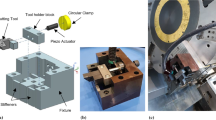Abstract
In internal turning of hardened steel carried out with cubic boron nitride (CBN) tools, the main concern is with the workpiece surface finishing, usually aiming to achieve a surface roughness similar to the attained in grinding processes along with gains in productivity. However, vibrations from the process often cause premature chipping in the tool and/or damage to the workpiece finishing. To minimize vibration, one solution is the use of passive and active dampers with different types of construction. Passive damper contrasts with active damper due to its low cost and simpler construction. The use of particle impact passive damper aided by compressed air to promote workpiece surface roughness reduction was studied. For this, different materials, particle size, packing ratio, and overhang boring bar were tested. Based on the results, it was possible to conclude that the airflow aided particle damper reduced the mean surface roughness by around 60% compared to non-airflow damping in 120 mm (L/D = 6) boring bar overhang.











Similar content being viewed by others
References
Anand A, Behera AK, Das SR (2018) Economic machining of hardened steels by hard turning and its process variables. Int J Eng Technol 7:320–325. https://doi.org/10.14419/ijet.v7i4.39.23954
Jakub Siwiec S, Zębala W (2012) Hard turning of cold work tool steel with CBN tools. Adv Manuf Sci Technol 36:19–32. https://doi.org/10.2478/v10264-012-0023-2
Vasanth XA, Paul PS, Lawrance G et al (2019) Vibration control techniques during turning process: a review. Aust J Mech Eng 00:1–21. https://doi.org/10.1080/14484846.2019.1585224
Bankar VK, Aradhye AS (2016) A review on active, semi-active and passive vibration damping. Int J Curr Eng Technol 6:2187–2191
Panossian HV (1992) Structural damping enhancement via NOPD technique. J Sound Vib 114:101–105. https://doi.org/10.1115/1.2930221
Sathishkumar B, Kumar MS, Mohanasundaram KM (2011) A case study on vibration control in a boring bar using particle damping. Int J Eng Sci Technol 3:177–184. https://doi.org/10.4314/ijest.v3i8.15
Pugnaloni LA, Sánchez M (2011) Effective mass overshoot in single degree of freedom mechanical systems with a particle damper. J Sound Vib 330:5812–5819. https://doi.org/10.1016/j.jsv.2011.07.016
Hlosta J, Žurovec D, Rozbro J et al (2018) Experimental determination of particle-particle restitution coefficient via double pendulum method. Chem Eng Res Des 21. https://doi.org/10.1016/j.cherd.2018.05.016
Sims ND, Sheffield S, Ridgway K (2005) Particle dampers for workpiece chatter mitigation. In: 2005 ASME International Mechanical Engineering Congress and Exposition, Orlando, pp 1–8. https://doi.org/10.1115/IMECE2005-82687
Xu Z, Yu M, Chen T (2005) Particle damping for passive vibration suppression: numerical modelling and experimental investigation. J Sound Vib 279:1097–1120. https://doi.org/10.1016/j.jsv.2003.11.023
Diniz AE, da Silva WTA, Suyama DI et al (2018) Evaluating the use of a new type of impact damper for internal turning tool bar in deep holes. Int J Adv Manuf Technol 101:1375–1390. https://doi.org/10.1007/s00170-018-3039-x
Bai X-M, Keer LM, JaneWang Q, Snurr RQ (2009) Investigation of particle damping mechanism via particle dynamics simulations. Granul Matter 11:417–429. https://doi.org/10.1007/s10035-009-0150-6
Sathishkumar B, Mohanasundaram KM, Kumar MS (2014) Impact of particle damping parameters on surface roughness of bored surface. Arab J Sci Eng 39:7327–7334. https://doi.org/10.1007/s13369-014-1209-1
Montgomery DC (1997) Design and analysis of experiments. Wiley, Nova Jersey
Takahashi Y, Sekine M (2015) Examination of particle behavior in container on multi-particle collision damper. Machines 3:242–255. https://doi.org/10.3390/machines3030242
Suyama DI, Diniz AE, Pederiva R (2016) The use of carbide and particle-damped bars to increase tool overhang in the internal turning of hardened steel. Int J Adv Manuf Technol 86:2083–2092. https://doi.org/10.1007/s00170-015-8328-z
Acknowledgments
The authors would like to thank the Faculty of Mechanical Engineering of the University of Campinas (FEM / UNICAMP), the Federal Institute of Education, Science and Technology of São Paulo (IFSP), and Sandvik for supplying the test equipment.
Author information
Authors and Affiliations
Corresponding author
Additional information
Publisher’s note
Springer Nature remains neutral with regard to jurisdictional claims in published maps and institutional affiliations.
Rights and permissions
About this article
Cite this article
de Aguiar, H.C.G., Hassui, A., Suyama, D.I. et al. Reduction of internal turning surface roughness by using particle damping aided by airflow. Int J Adv Manuf Technol 106, 125–131 (2020). https://doi.org/10.1007/s00170-019-04566-5
Received:
Accepted:
Published:
Issue Date:
DOI: https://doi.org/10.1007/s00170-019-04566-5



